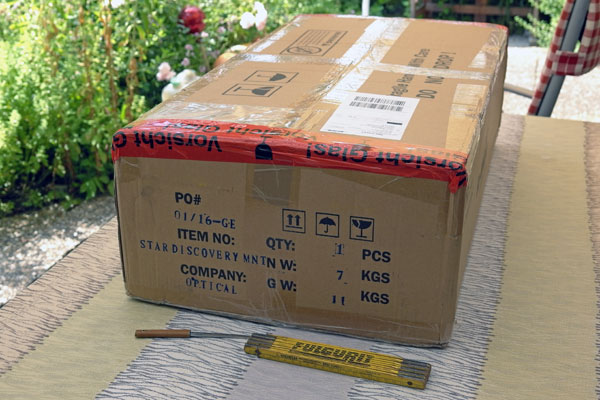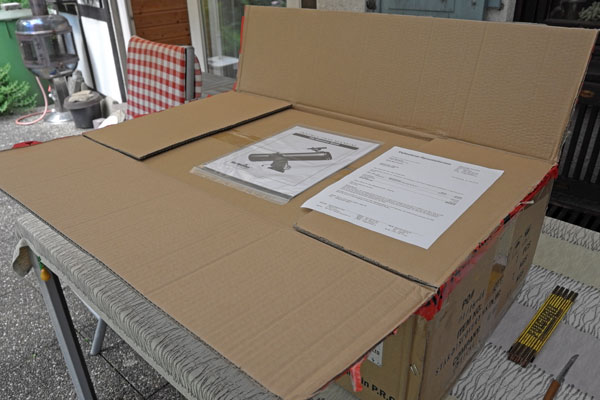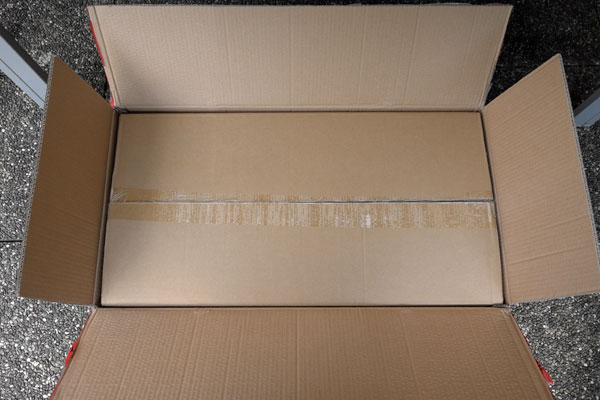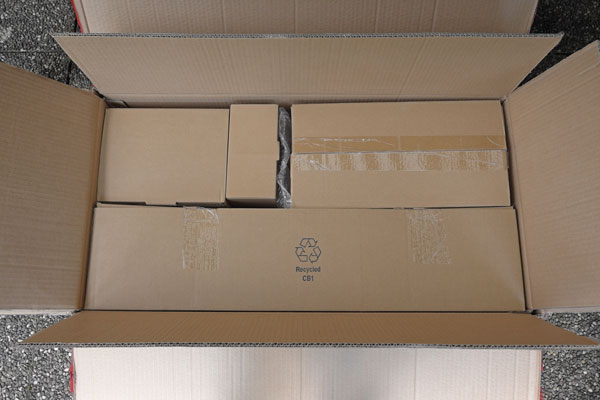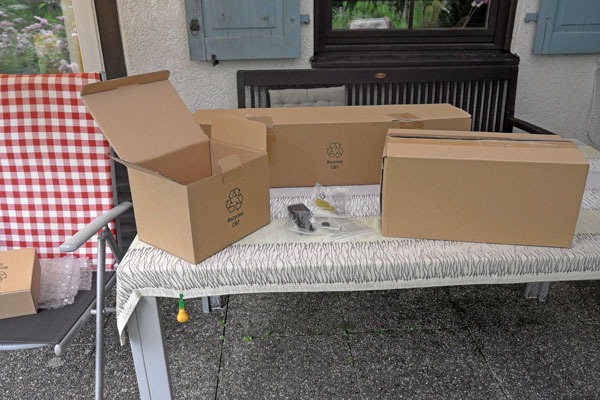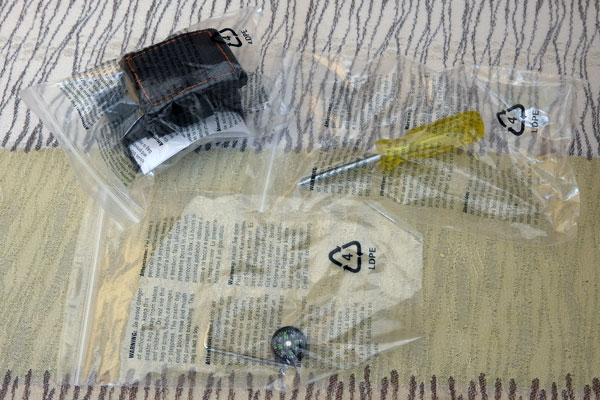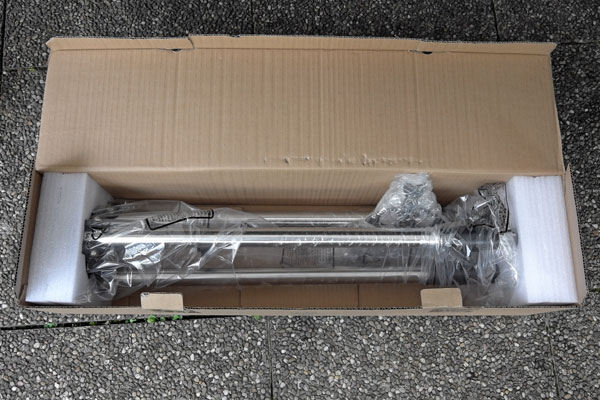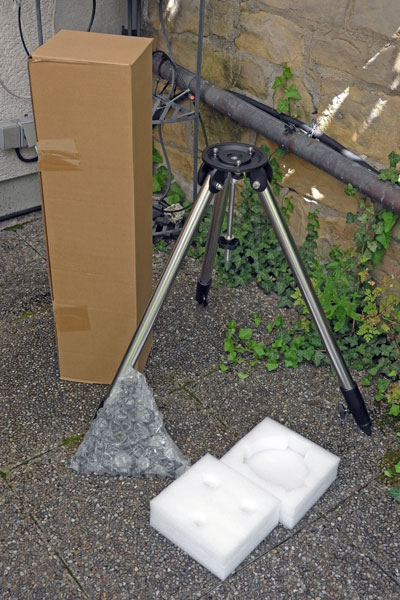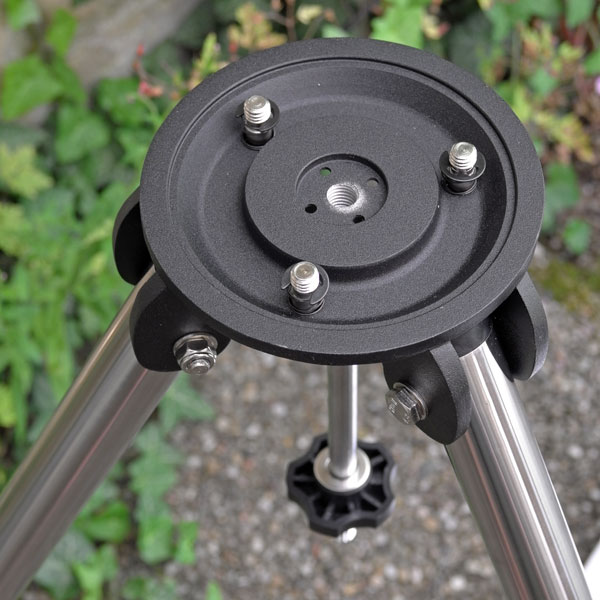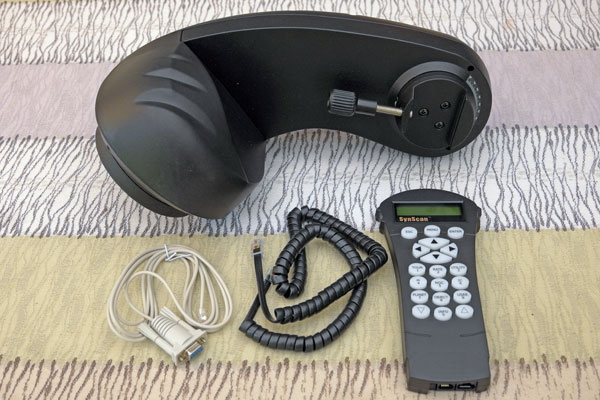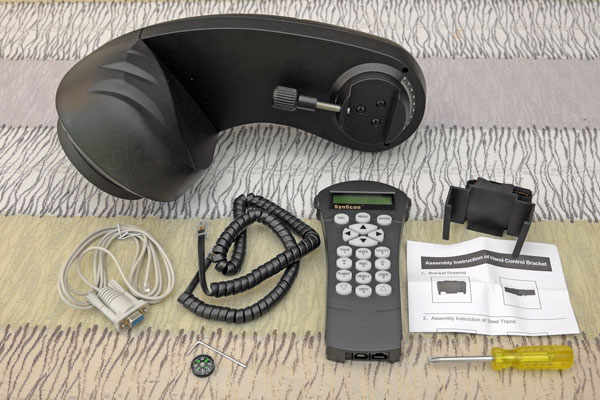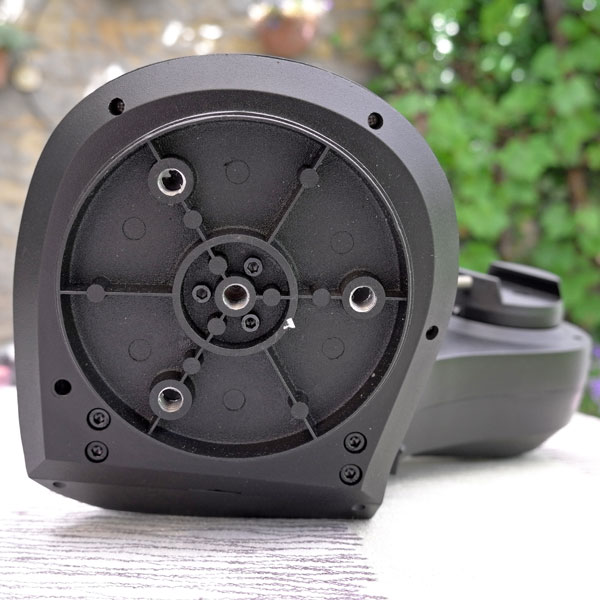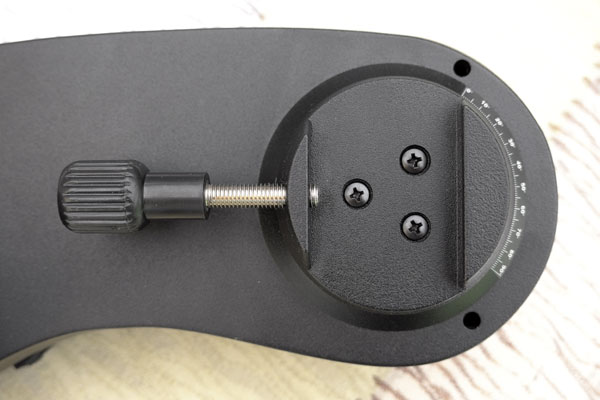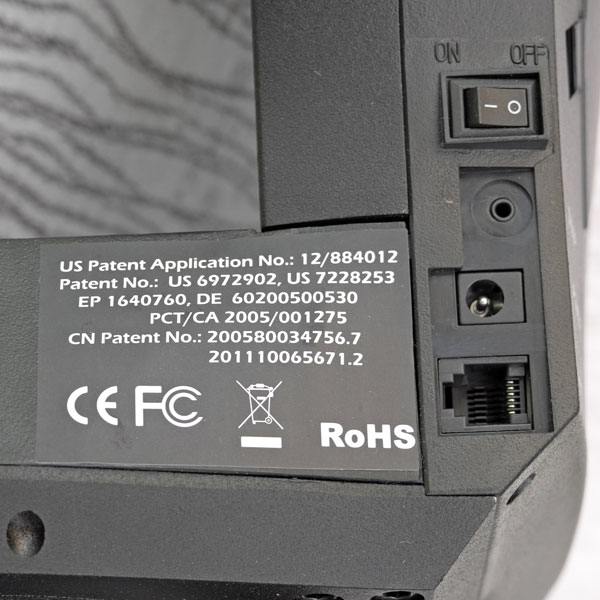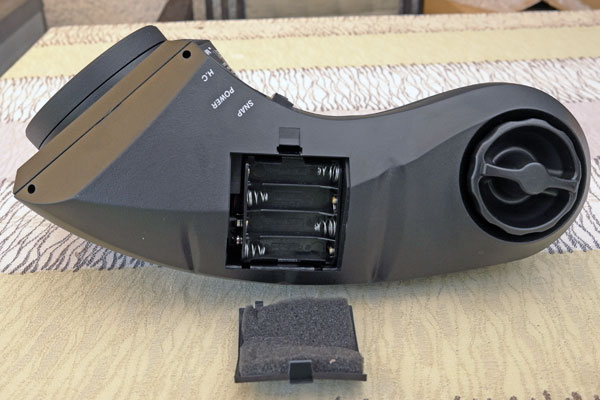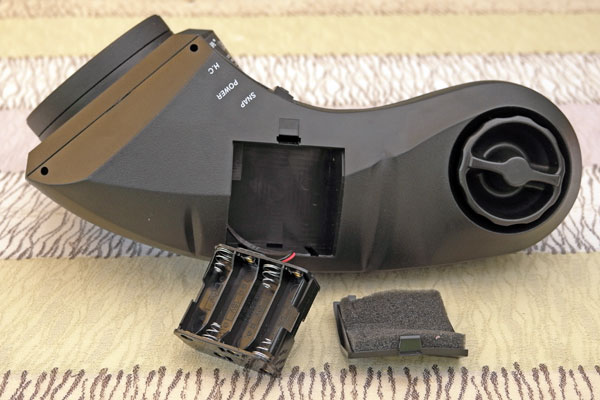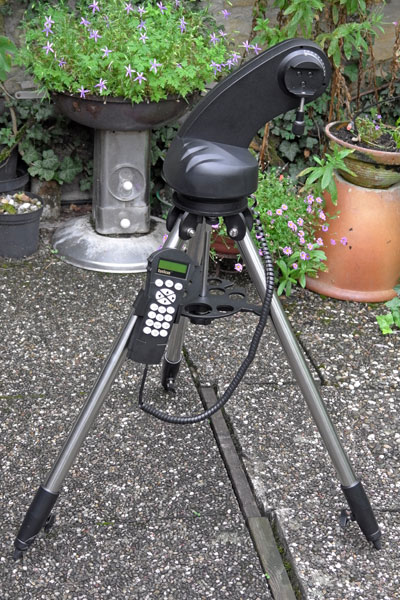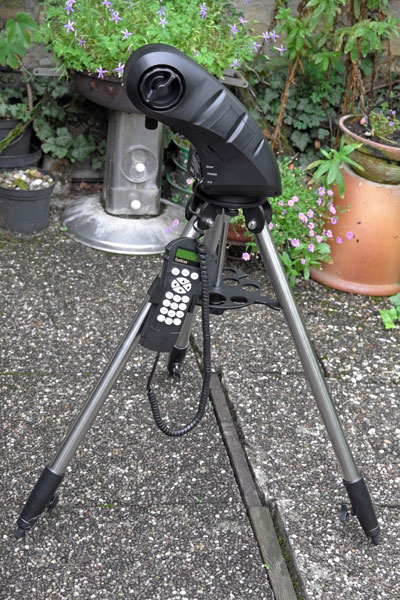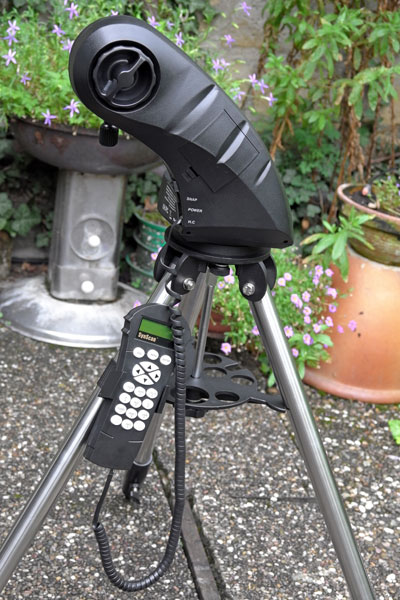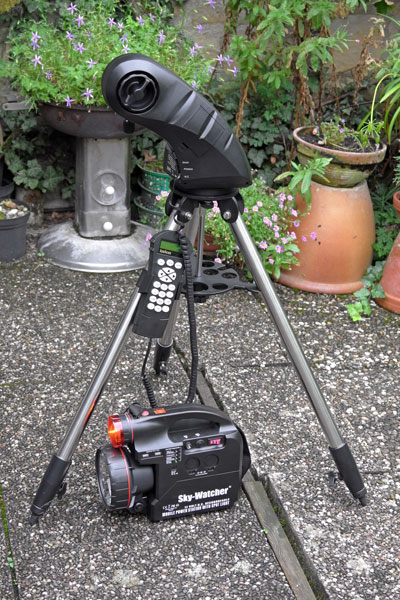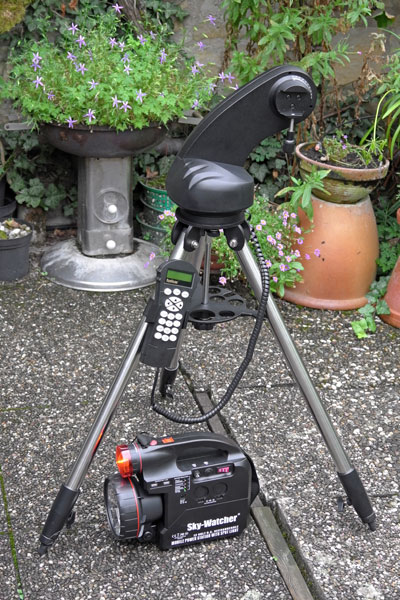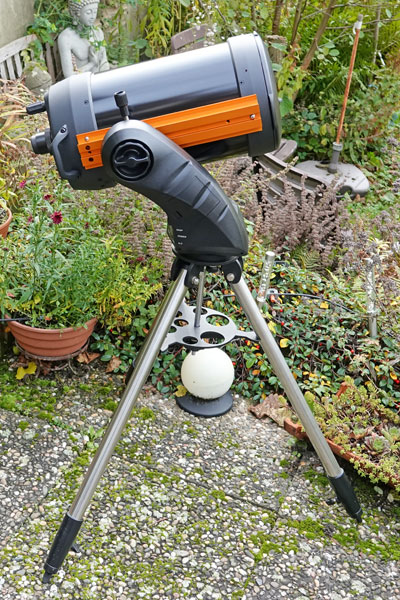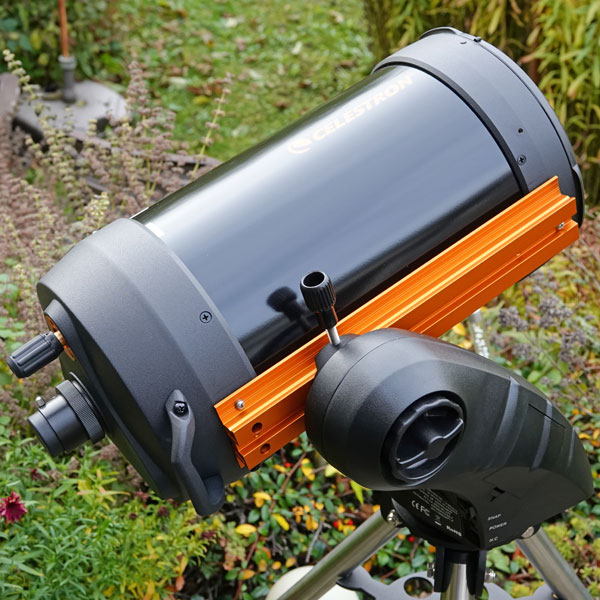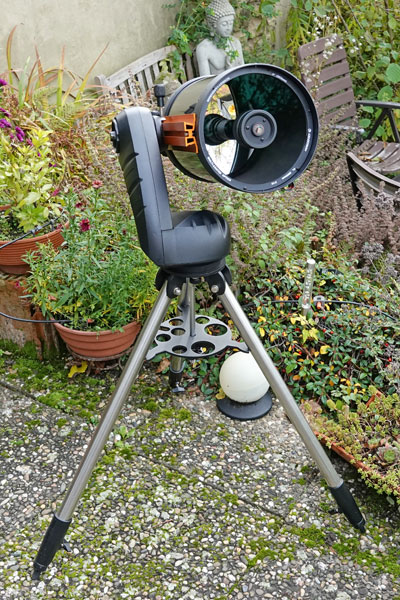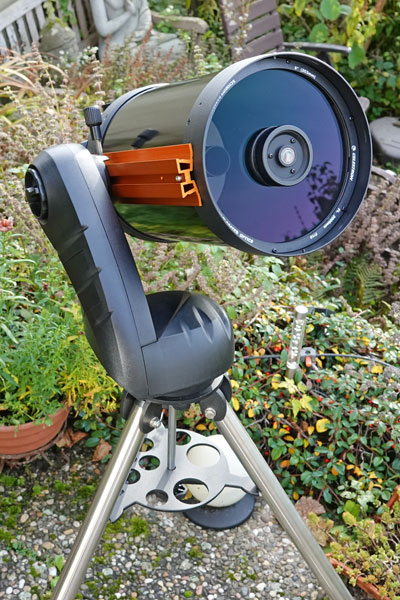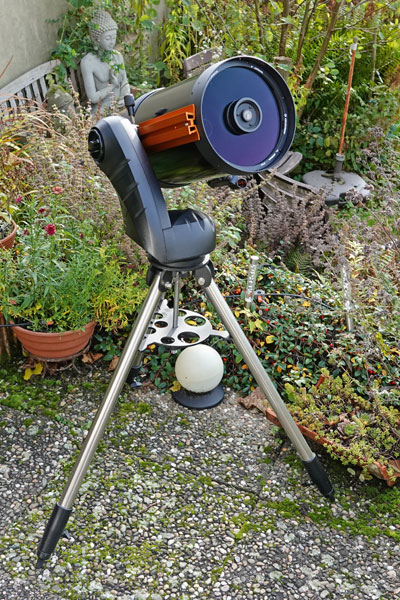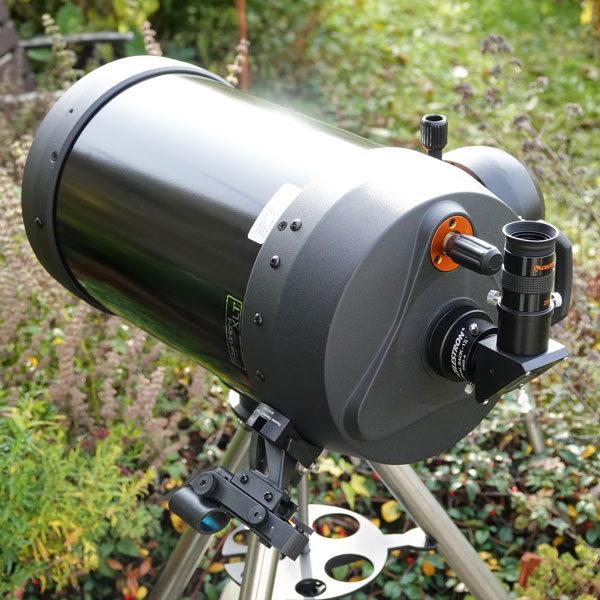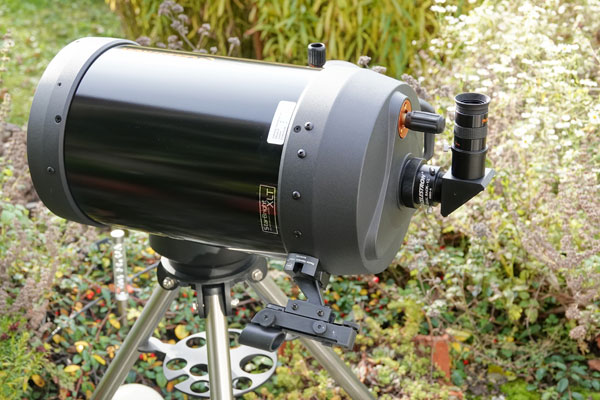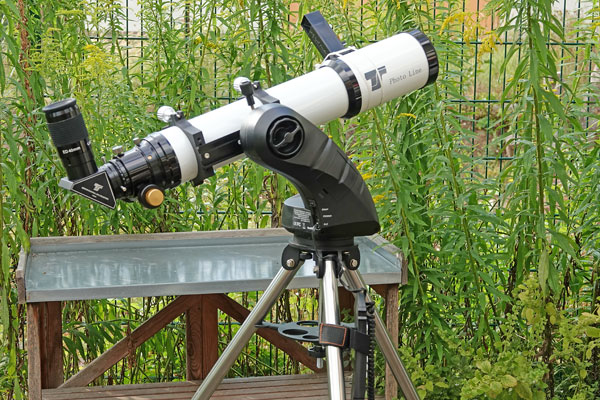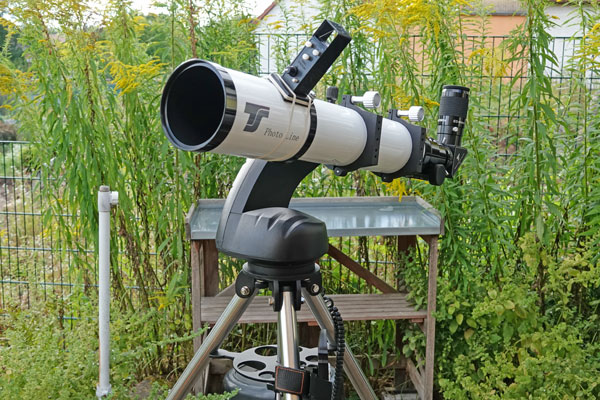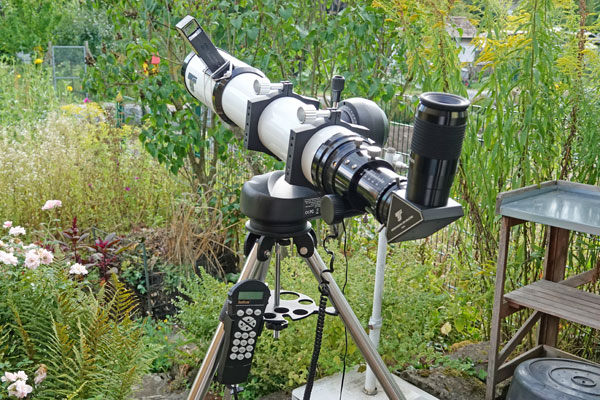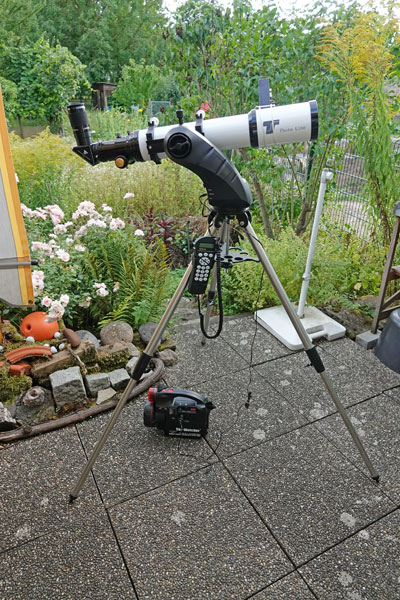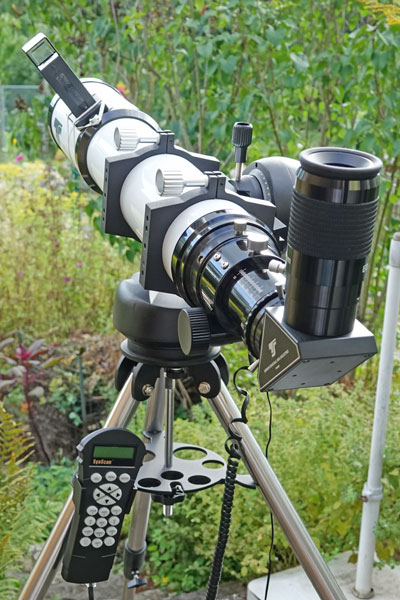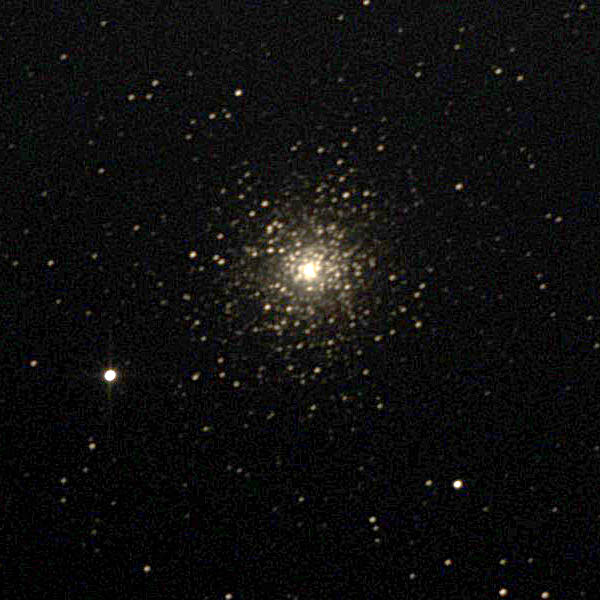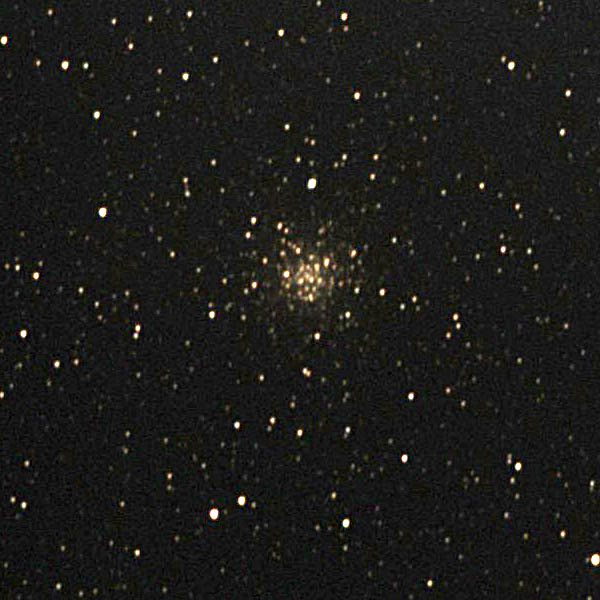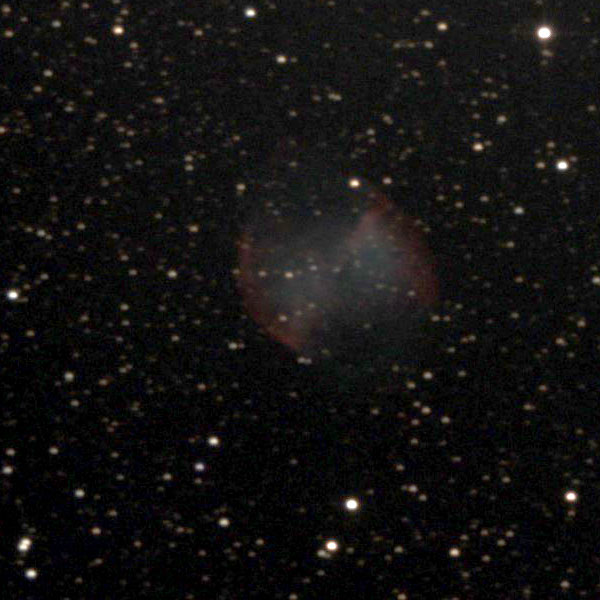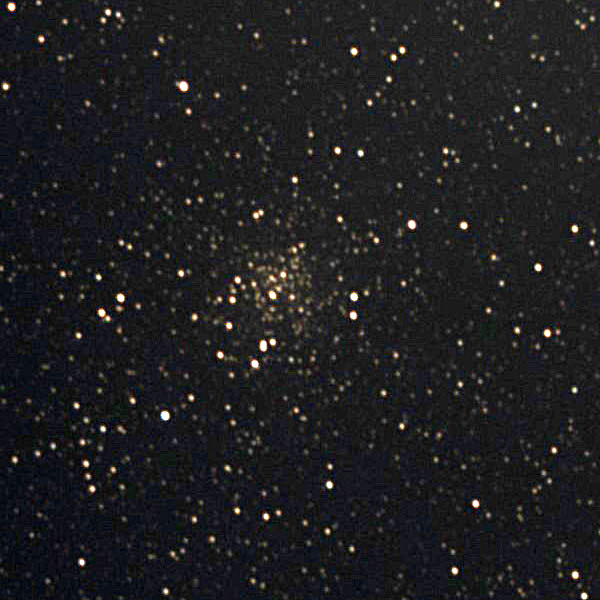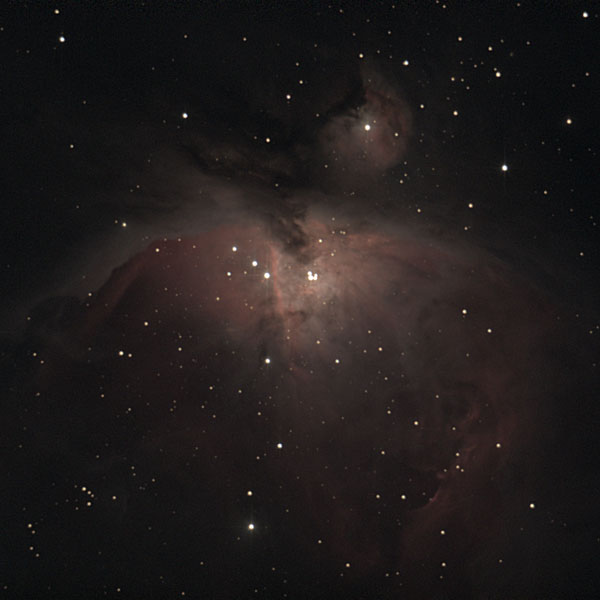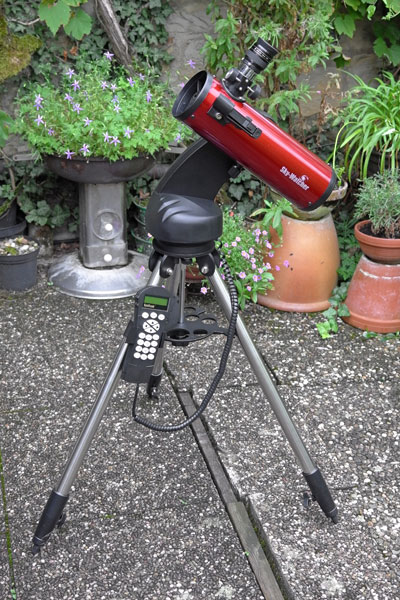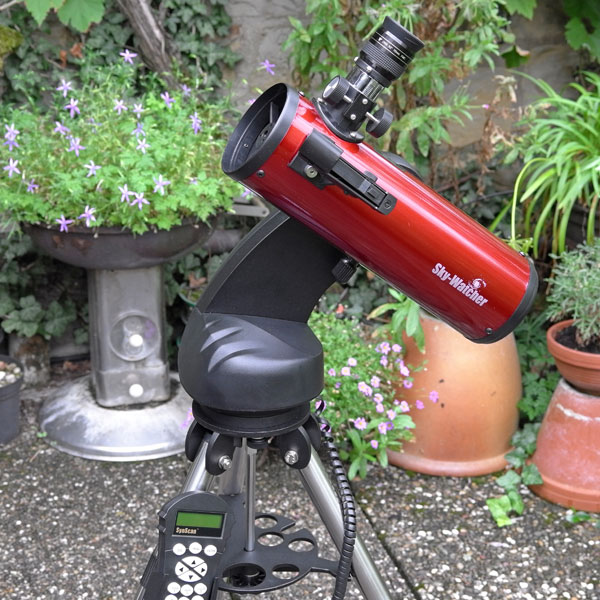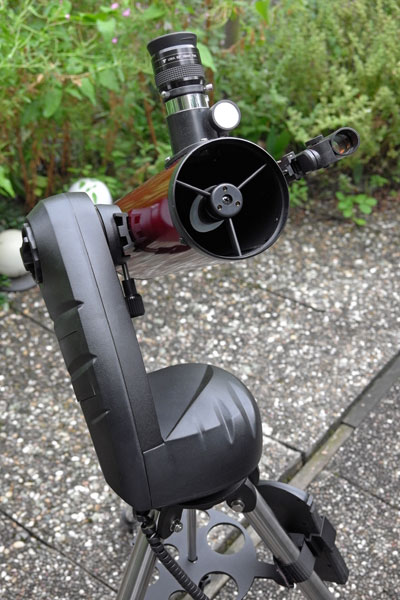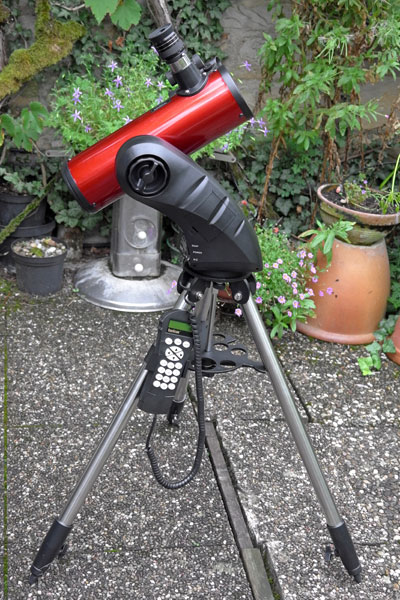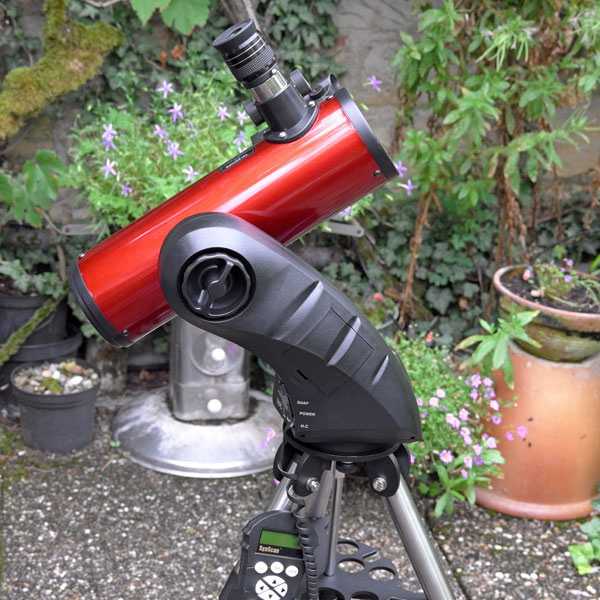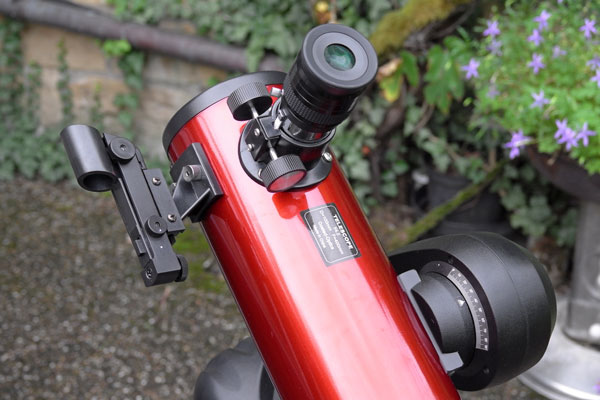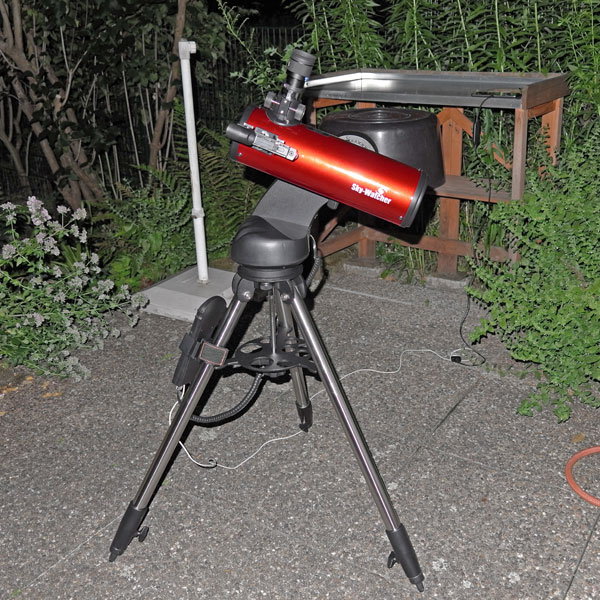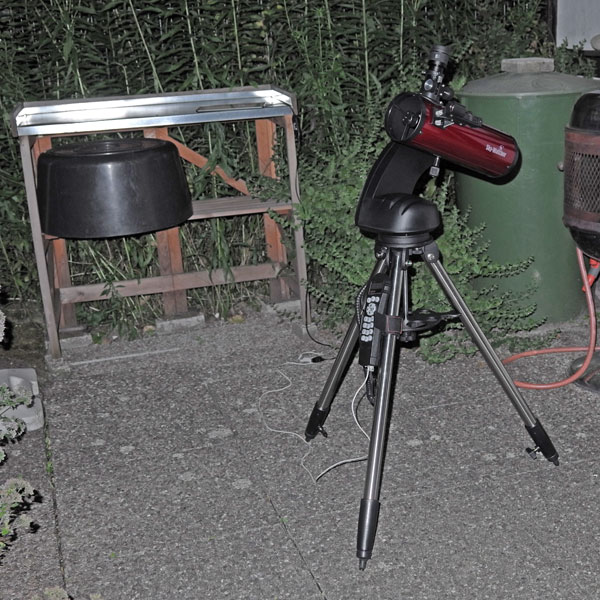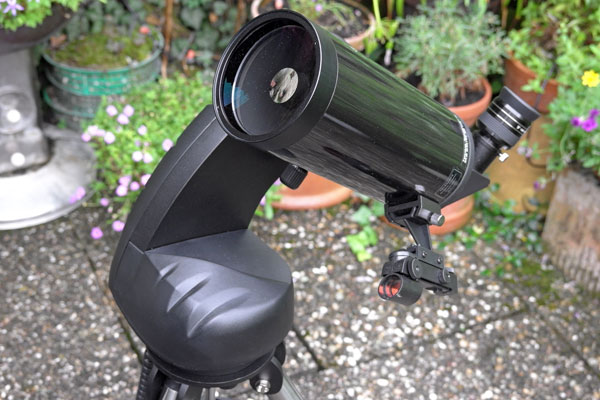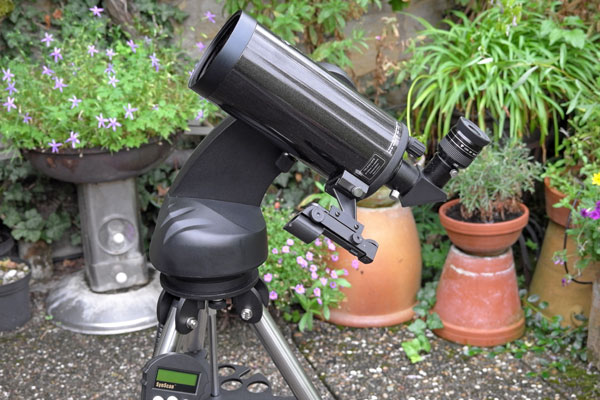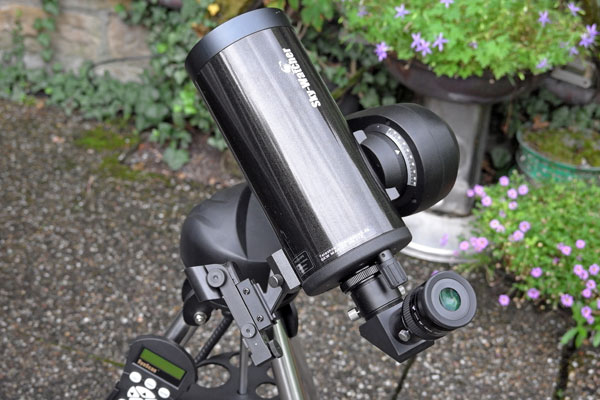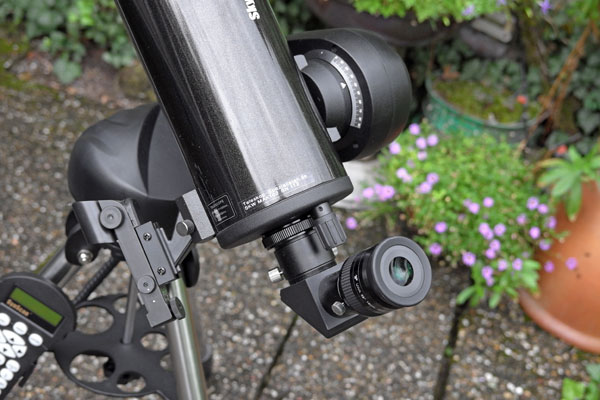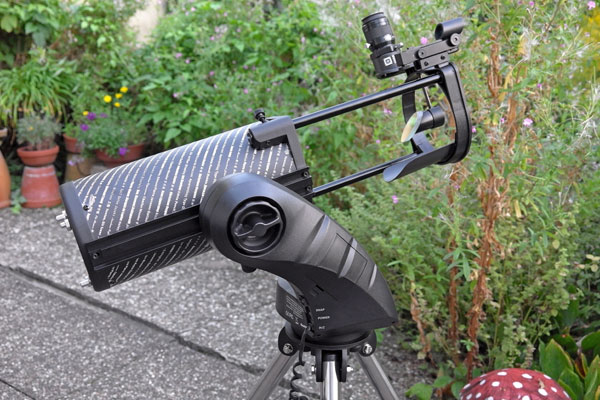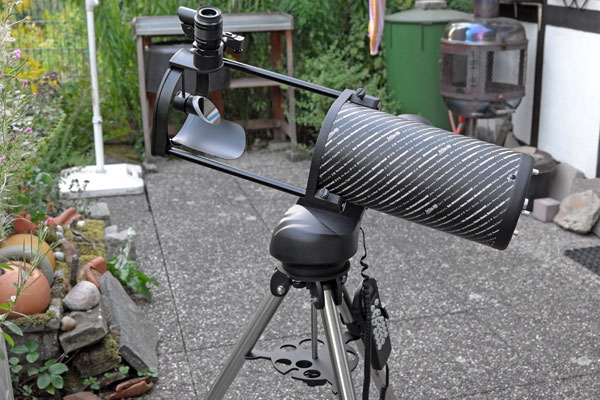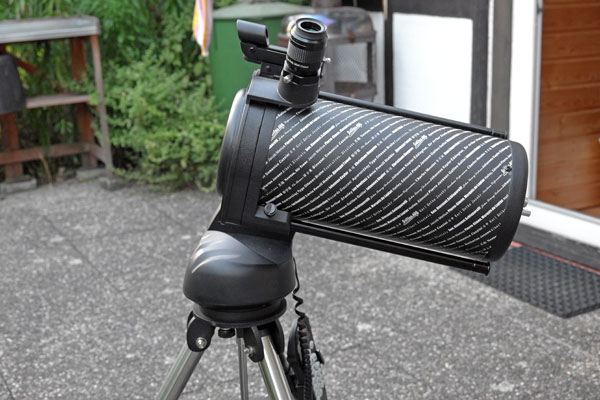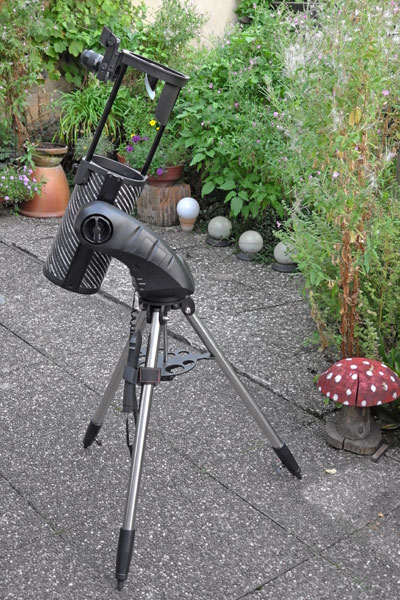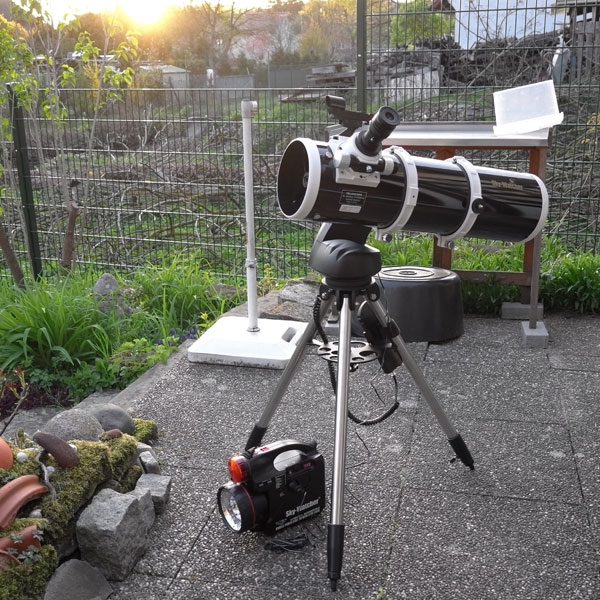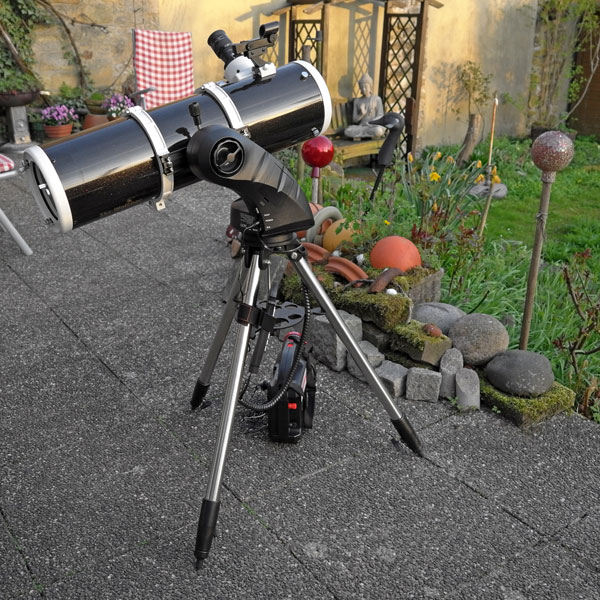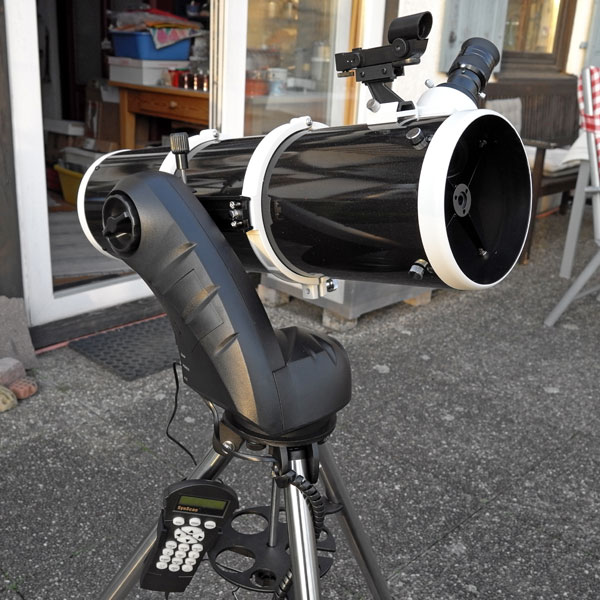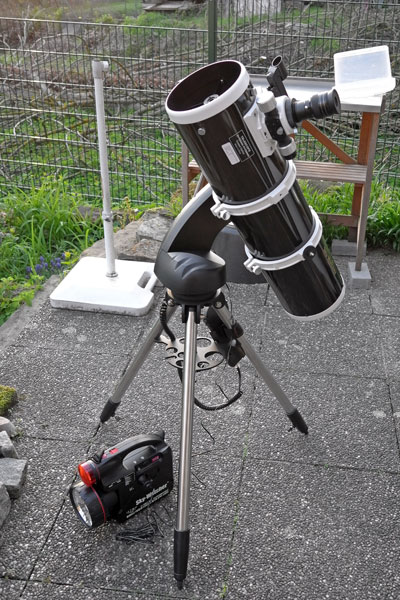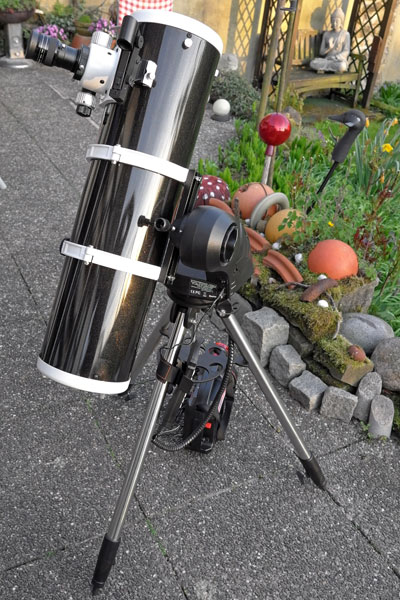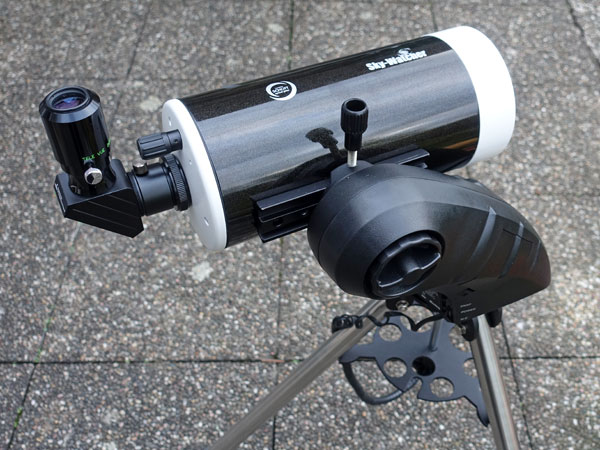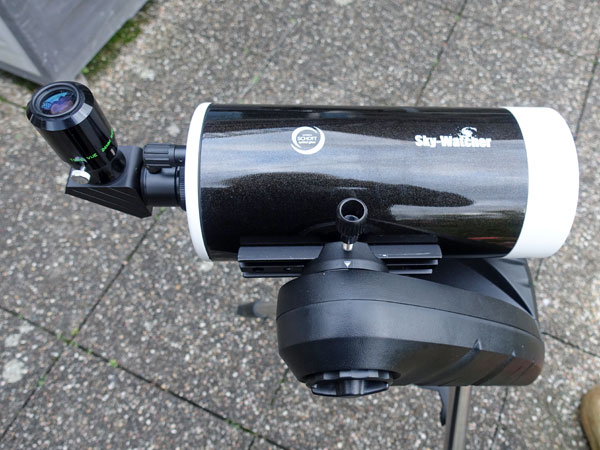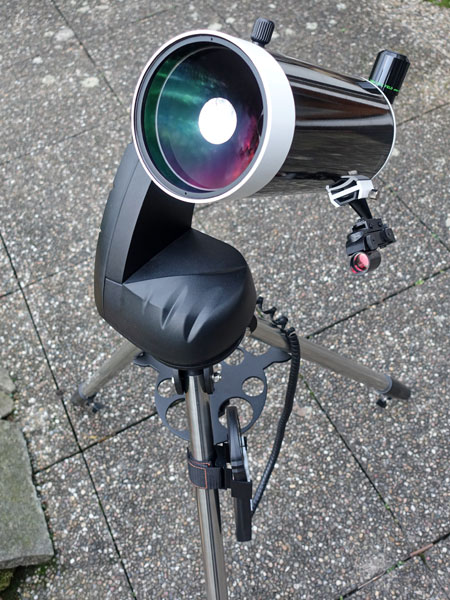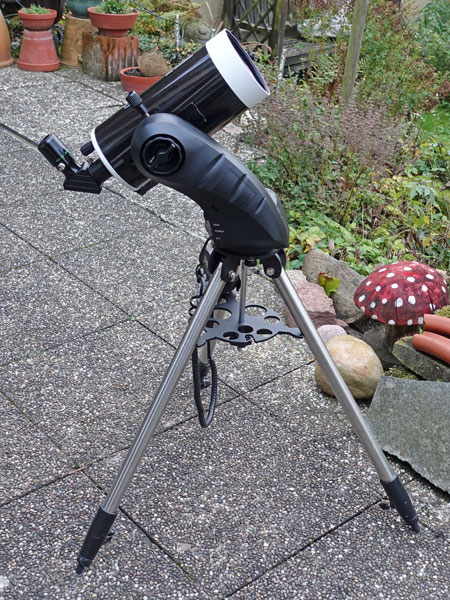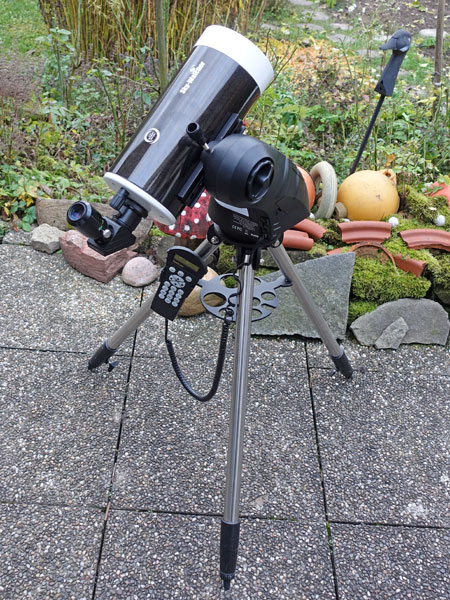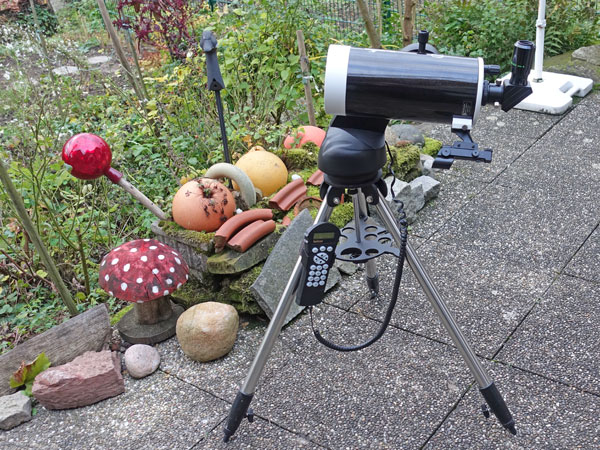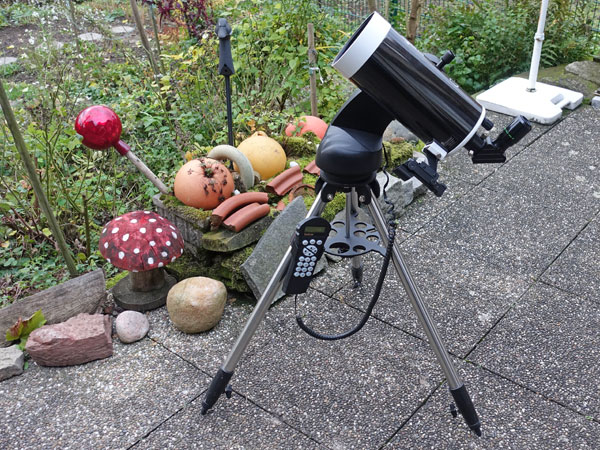Sky-Watcher Star Discovery AZ GoTo Mount Information
Look | Look with Telescope Tubes | First Photo Attempts | Preliminary Conclusions | Links || Appendix: Data | Appendix 2: Look with Previous Telescope Tubes
Archive
On this page, I present some information about my Sky-Watcher Star Discovery AZ GoTo telescope mount (ordered on July 12, 2016 , arrived on July 18 after adjustment at the dealer's). Initially, I used the Sky-Watcher Heritage 100P, Sky-Watcher Heritage P130, and Explorer 150PDS Newton telescope tubes, the Skymax-102 OTA, and the Skymax-127 OTA on this azimuthal mount (for photos, see the appendix 2). Therafter, I use dthe Celestron C8 and the TS-Optics TLAPO1027 on this mount - see the photos further below.
The Sky-Watcher Star Discovery AZ GoTo telescope mount seems to be identical to the Orion StarSeeker IV GoTo AZ Mount (I asked a dealer for this). The latter is, however, 100 EUR more expensive and is advertised as able to carry a maximum load of up to 6 kg.
See here my experiences that I made so far with "overloading the mount with a 6" Newton tube." For accessories and tubes that I bought in the course of time, see Sky-Watcher Star Discovery AZ GoTo Mount - First Experiences.
| Note: I sold my Sky-Watcher Star Discovery AZ GoTo telescope mount at the end of November 2024. I therefore can no longer report any further experiences with this mount here. I also parted with all the extensions. |
See the appendix for the data.
See also:
- Sky-Watcher Star Discovery AZ GoTo Mount - SkyWire Information Archive
- Sky-Watcher Star Discovery AZ GoTo Mount - SynScan WLAN Information Archive
- Celestron StarSense AutoAlign for Sky-Watcher Information Archive
- Sky-Watcher Star Discovery AZ GoTo Mount - First Experiences Archive
- Sky-Watcher Star Discovery AZ GoTo Mount - General Experiences and Thoughts Archive
- Sky-Watcher Star Discovery AZ GoTo Mount - Adaptation to Heavier Loads Archive
- Sky-Watcher Star Discovery AZ GoTo Mount - Named and Alignment Stars Archive
- Sky-Watcher Star Discovery AZ GoTo Mount - Control Options Archive
- Sky-Watcher Star Discovery AZ GoTo Mount - Instructions Archive
- Sky-Watcher Star Discovery AZ GoTo Mount - SynScan WLAN - First Experiences Archive
- Sky-Watcher Star Discovery AZ GoTo Mount - SynScan WLAN - Further Experiences Archive
- Celestron StarSense AutoAlign for Sky-Watcher - First Experiences Archive
- Celestron StarSense AutoAlign for Sky-Watcher - Further Experiences Archive
Look
Unpacking
|
Outer package |
Ditto Package dimensions
: Gross weight: 11 kg (9.8 kg, own measurement), net weight: 7 kg |
Ditto |
|
Ditto, opened |
Ditto |
Ditto |
|
Inner boxes "out of the box" |
Ditto |
Tools, hand box holder, compass.... |
|
View of the opened box with mount and further parts |
View of the opened tripod box |
Tripod (accessory tray not assembled) |
|
Tripod head |
Mount box empty... |
Content of the mount box |
|
Content of the mount box, unpacked* |
Ditto, with further accessories* |
Mount from bottom |
|
Dovetail mount for telescope tubes (Vixen type) |
Mount seen more from below and the side |
Switch and connections at the mount, detail |
|
Mount from other side with battery compartment |
Battery compartment opened |
Battery holder (8 x AA) |
*) The cable for connecting the mount to the handbox is an RJ45 to RJ12 cable. The 8-pin RJ45 plug is plugged into the handbox, the 6-pin RJ12 plug is plugged into the mount. The RJ12 socket in the handbox is used to connect a serial RS232 cable (for connection to a computer).
Mount Assembled
|
Mount from one side |
Ditto, overall view |
Mount turned around |
|
Ditto, overall view |
Ditto with external power supply (Sky-Watcher Power Tank 12 V / 7 Ah) |
Ditto, mount turned around |
Look with Telescope Tubes
For the look with previous telescope tubes see Appendix 2: Look with Previous Telescope Tubes.
C8 on Star Discovery Mount
Star Discovery Mount with TLAPO1027 Refractor
First Photo Attempts
In November 2017, I bought an Atik Infinity camera, and now it was possible for me to take photos of deep sky objects, albeit not high-quality ones. I present those photos primarily on the Atik Infinity pages (and the telescope pages), but here are a few early attempts that I took with this camera mounted to the Explorer 150PDS tube.
Explorer 150PDS
Preliminary Conclusions
First attempts at using the GoTo mount with my different telescope tubes were encouraging on the one hand, but on the other hand, they were sometimes very frustrating. Sometimes, I quickly managed to align the mount well (using two stars), but sometimes not at all. In part, these differences can be attributed to the difference in magnification that can be achieved with the tubes - the Heritage 100P is the most benign in this respect because of its low focal length (and thus, magnification). In part, it may also have been a matter of how far apart the observed objects were in the sky.
Over the years, I have already been able to find and observe a number of deep-sky objects with the GoTo mount. I have begun to describe my "deep-sky experiences of a beginner" on separate pages. This is, of course, a "never ending project"...
All in all, the mount has opened the way to the world of deep-sky objects for me, also because I finally acquired the appropriate literature. Without this and a certain preparation for the observation objects, it just does not seem to work, as my experience shows. Thus, in 2016 I was able to observe more such objects than in my whole life before. In addition, these experiences helped me to find larger deep-sky objects without technology, but with literature, using compact and thus, easily transportable telescopes on my vacations!
Extensions
In July 2016, I purchased a SouthernStars SkyWire Serial Accessory (wired) to enable me to control the mount with an iPad running SkySafari. Basically, the SkyWire Serial Accessory worked without complaints with the Star Discovery mount and the SkySafari program on the iPad; however, the initial alignment had still to be done with the hand control of the mount. On the positive side, it did not require a power supply. In the long run, however, the wired operation bothered me to much. Therefore, I purchased the optional Sky-Watcher SynScan WLAN adapter in April 2019 in order to be able to control the Star Discovery mount wirelessly (in the meantime, the mount is only sold with the WLAN module; I gave away the SkyWire adapter). Initially, I had a lot of problems with using the Wi-Fi module, but in the meantime I managed to control the mount with it, whereby the iPhone is recommended instead of an iPad.
Already in February 2018, I purchased the Celestron StarSense module in the "for Sky-Watcher" version, to be able to observe without a tedious star alignment procedure. Again, getting started with this module was more than bumpy. And it has its own handbox, which differs from the Sky-Watcher one in some important aspects (which can lead to confusion)...
Read more about the extensions on the following and further pages:
- Sky-Watcher Star Discovery AZ GoTo Mount - SkyWire Information Archive
- Sky-Watcher Star Discovery AZ GoTo Mount - SynScan WLAN Information Archive
- Celestron StarSense AutoAlign for Sky-Watcher Information Archive
- Sky-Watcher Star Discovery AZ GoTo Mount - Control Options Archive
| Note: I sold my Sky-Watcher Star Discovery AZ GoTo telescope mount at the end of November 2024. I therefore can no longer report any further experiences with this mount here.I also parted with all the extensions. |
Links
- Sky-Watcher Company Website, USA: www.skywatcher.com
(the Star Discovery AZ GoTo Mount is not found on the company Website) - Pages from German distributors for the Sky-Watcher Star Discovery AZ GoTo
Telescope Mount:
- Teleskop-Spezialisten (here I bought the mount): www.teleskop-spezialisten.de/shop/Montierungen/Azimutale-Montierung-ALT/AZ/Skywatcher-Star-Discovery-AZ-GoTo-Teleskop-Montierung-inkl-Stahlstativ-bis-5kg::1863.html (in German)
- Astroshop: www.astroshop.de/azimutal-mit-goto/skywatcher-montierung-az-synscan-goto-star-discovery/p,50254#tab_bar_1_select (in German) - www.astroshop.eu/alt-azimuth-with-goto/skywatcher-az-synscan-goto-star-discovery-mount/p,50254 (in English)
- Orion StarSeeker IV GoTo AZ Mount & Tripod (Orion Store): www.telescope.com/catalog/product.jsp?productId=114480
- Pages from German distributors for the Orion StarSeeker IV GoTo AZ Mount & Tripod:
- See also my page offering Astronomy Links.
Appendix: Data for Sky-Watcher Star Discovery AZ GoTo Telescope Mount
Package Content
- Star Discovery AZ GoTo Mount
- Tripod (stainless steel, with eyepiece-plate, 1,25" diameter)
- SynScan 4 hand box
Data
- Hand box: Sky-Watcher SynScan V4 hand control
- WiFi: Possible with the optional SynScan WiFi module
- Data basis for celestial objects: > 42.900 objects, Messier, NGC, IC and SAO objects
- Adjustment method: 2-star or proposed by mount; see also SynScan app if used with the optional SynScan module
- Encoders: Inbuilt - Freedom-Find dual-encoder technology
- Tracking speeds: Siderial, lunar, and solar
- Movement speeds: 1.0x, 2.0x, 16x, 32x, 64x, 128x, 400x, 500x, 600x, 800x
- Maximum additional weight: Telescopes up to 5 kg weight
- Mounting saddle: Vixenstyle
- DSLR camera port: with optional DSLR cables
- Upgrade: The mount can be upgraded via the Internet (my dealer warned me to use the current version, though!)
- Power supply: 12 V (batteries or e.g. Sky-Watcher PowerTank, which I also bought)
Appendix 2: Look with Previous Telescope Tubes
Star Discovery Mount with Heritage 100P Telescope Tube (and with SkyWire GoTo Control for iPad)
|
Heritage 100P tube on mount (overall view) |
Ditto (detail) |
Front view |
|
Heritage 100P tube on mount, turned around (overall view) |
Ditto (detail) |
Top view |
|
Heritage 100P tube on mount (with tripod); SkyWire GoTo control lying on the ground, iPad lying on the table (both hard to see...) |
Ditto; SkyWire GoTo control lying on the ground, iPad lying on the table (both hard to see...) |
Note: The Heritage 100P is no longer in my possession because I gave it away to my brother.
Star Discovery Mount with Skymax-102 OTA
When I use the tube on my Star Discovery AZ GoTo mount, this regrettably results in an unusable position of the red dot finder.
|
Skymax-102 tube on mount (overall view) |
Ditto (Detail) |
Front view |
|
Skymax-102 tube on mount, turned around (overall view) |
Ditto (detail) As noted elsewhere, the position of the red dot finder is not very useful |
Rear view |
|
Ditto (detail) |
Note: The Skymax-102 is no longer in my possession because I sold it.
Star Discovery Mount with Heritage P130 Telescope Tube
The Heritage P130 tube weighs less than 4 kg and can therefore be used on the Star Discovery mount. Here are some photos:
|
P130 "compact" seen
from the side
|
P130 in "working mode" seen from the side |
Ditto, seen from the other side |
|
P130 "compact", seen from the other side |
P130 in "working mode", overview |
Ditto, seen from the other side |
Note: The Heritage P130 is no longer in my possession because I gave it away to a friend.
Star Discovery Mount with Explorer 150PDS Newton Tube
The Explorer 150PDS Newton tube weighs about 5.5 kg "alone" and can therefore be used on the Star Discovery mount only with caution (see here for my experiences with this combination that I made so far). Below are some photos:
Note: The Explorer 150PDS is no longer in my possession because I sold it in January 2020.
Star Discovery AZ GoTo Mount with Skymax-127 OTA
When I use the tube on my Star Discovery AZ GoTo mount, this regrettably results in an unusable position of the red dot finder.
|
Skymax-102 tube on the GoTo mount |
Ditto |
View from above - you can see the label indicating that Schott glass is used |
|
Front view - you can clearly see the impractical position of the finder |
Side view (overall view) |
Seen from the back (overall view) |
|
Skymax-102 tube on GoTo mount (overall view) |
Ditto |
|
Note: The Skymax-127 is no longer in my possession because I sold it at the end of January 2021.
| 14.01.2025 |


